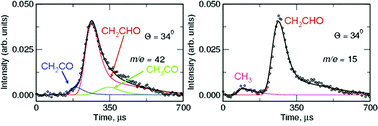In this Perspective we highlight developments in the field of chemical reaction dynamics. Focus is on the advances recently made in the investigation of the dynamics of elementary multichannel radical–molecule and radical–radical reactions, as they have become possible using an improved crossed molecular beam scattering apparatus with universal electron-ionization mass spectrometric detection and time-of-flight analysis. These improvements consist in the implementation of (a) soft ionization detection by tunable low-energy electrons which has permitted us to reduce interfering signals originating from dissociative ionization processes, usually representing a major complication, (b) different beam crossing-angle set-ups which have permitted us to extend the range of collision energies over which a reaction can be studied, from very low (a few kJ mol−1, as of interest in astrochemistry or planetary atmospheric chemistry) to quite high energies (several tens of kJ mol−1, as of interest in high temperature combustion systems), and (c) continuous supersonic sources for producing a wide variety of atomic and molecular radical reactant beams. Exploiting these new features it has become possible to tackle the dynamics of a variety of polyatomic multichannel reactions, such as those occurring in many environments ranging from combustion and plasmas to terrestrial/planetary atmospheres and interstellar clouds. By measuring product angular and velocity distributions, after having suppressed or mitigated, when needed, the problem of dissociative ionization of interfering species (reactants, products, background gases) by soft ionization detection, essentially all primary reaction products can be identified, the dynamics of each reaction channel characterized, and the branching ratios determined as a function of collision energy. In general this information, besides being of fundamental relevance, is required for a predictive description of the chemistry of these environments via computer models. Examples are taken from recent on-going work (partly published) on the reactions of atomic oxygen with acetylene, ethylene and allyl radical, of great importance in combustion. A reaction of relevance in interstellar chemistry, as that of atomic carbon with acetylene, is also discussed briefly. Comparison with theoretical results is made wherever possible, both at the level of electronic structure calculations of the potential energy surfaces and dynamical computations. Recent complementary CMB work as well as kinetic work exploiting soft photo-ionization with synchrotron radiation are noted. The examples illustrated in this article demonstrate that the type of dynamical results now obtainable on polyatomic multichannel radical–molecule and radical–radical reactions might well complement reaction kinetics experiments and hence contribute to bridging the gap between microscopic reaction dynamics and thermal reaction kinetics, enhancing significantly our basic knowledge of chemical reactivity and understanding of the elementary reactions which occur in real-world environments.


 Please wait while we load your content...
Please wait while we load your content...